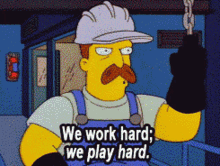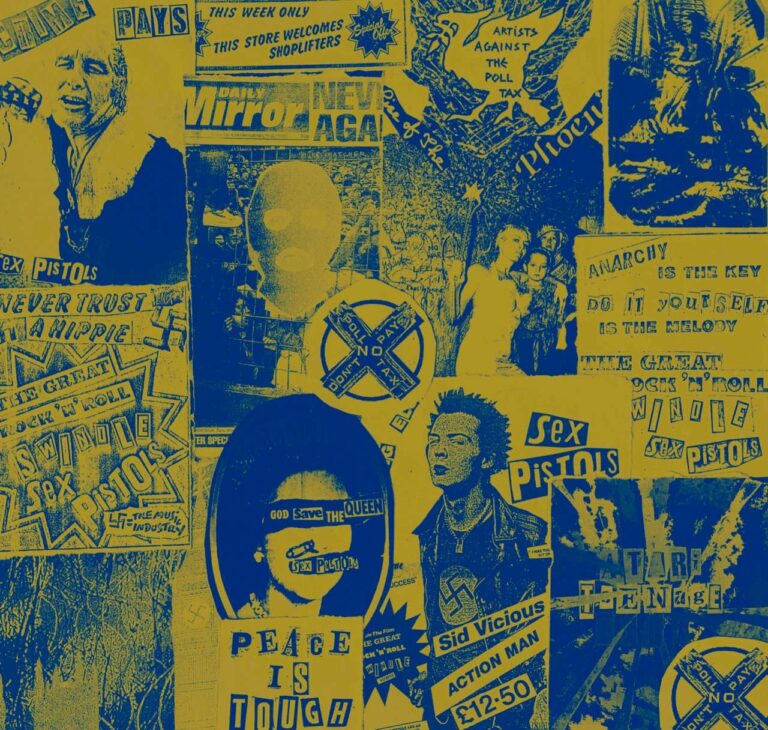As the world ends and then ends again in more vile ways, this year, visions of mangroves and the Lilith’s Brood trilogy by Octavia E. Butler have been my close company. Dawn (Lilith’s Brood, Book I) begins with the aftermath of missiles that killed almost the entire human race along with all possibility of life on earth. Lilith awakens on a spaceship to the Oankali, an alien race. They have sensory tentacles, like slick oily hair, tendrils cover their body and lick the air. They do not need eyes to see. They know something we don’t. They have decided to keep the few remaining humans in suspended animation until the time is right.
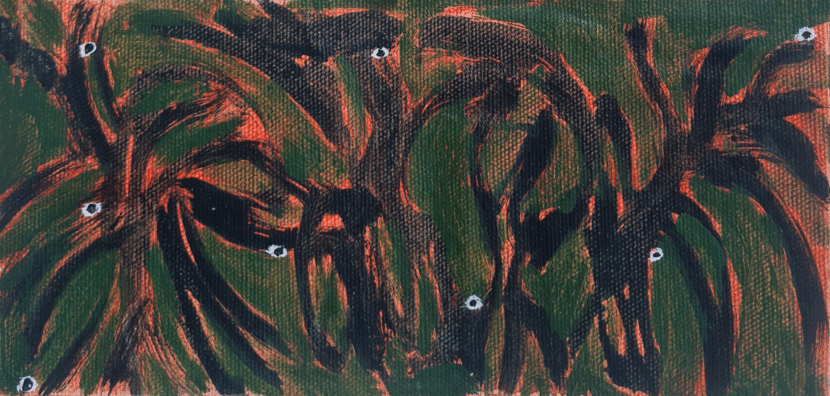 Mangrove Eyes 1 2025
Mangrove Eyes 1 2025
We are witnessing the prelude to Butler’s Dawn in real time.
Awakening was hard, as always. The ultimate disappointment. – Lilith. 1
In Gaza the annihilation of land, air, infrastructure, the mass murder of people, whole bloodlines killed by missiles and weapons designed to destroy all life, is ongoing. I watch with wet eyes, sensing, staring into my little black mirror. In Sudan approximately 522,000 children have died from war-induced famine since 2024. I am still staring into my little black mirror, sensing, witnessing. Butler wrote about these genocides 36 years before 2023, because these types of killings are familiar, they have already been happening, they are practiced; they have been rehearsed.
It is alleged that on August 13th 2024, a group of young activists broke into an Israeli arms facility in Bristol and decommissioned weapons, including quadcopter drones, which are known to target children in Gaza. This group of young people have been imprisoned without bail for over a year on misused counter-terrorism charges. One of the activists Fatema Zainab writes Do not forget the IOF tactics across Palestine are an evolution of British counterinsurgency methodology to repress uprising of the colonies.
I put my phone away, stretch my limbs and try to re-enter my body.
We enter a mangrove thicket. Sticky humid air. Their upward roots are snorkels breathing oxygen into their submerged body. The pores on my skin open, lenticels breathing in oxygen. We are sensing.
At the beginning of the year I spent time with mangroves on the south coast of Sri Lanka.
Mangrove forests grow on the edges of coastlines, that liminal space between sea and land. I am walking on this sandy in-between, the mangrove roots might trip me, I am reaching towards them. They offer shade and privacy. One cow, two, three, four become visible leaving the mangrove, huge beings hidden from sight.
Mangroves live in brackish water across 123 countries, they survive in tropical and temperate climates. It is estimated that there are 52,000 km2 of mangrove forests. That means mangroves occupy about 0.12% of this earth’s terrestrial surface. In the last 50 years, this earth has lost half of its mangrove forests at a rate of 1% per year, due to conversion to shrimp farms, croplands, waterfront development, and deforestation for fuel wood and charcoal production. Mangroves provide an ideal breeding and nesting home for fish, and other creatures like crabs and sea flora and fauna, which in turn provides food and livelihoods for local communities. Mangroves also offer protection from rising sea-levels and coastal erosion, both also caused by environmental destruction.
As the tourist colonisation erases the coastline, in ways that are not unlike, nor unrelated to the 2004 tsunami, the stretches where mangroves take up the most space can feel like a long exhale.
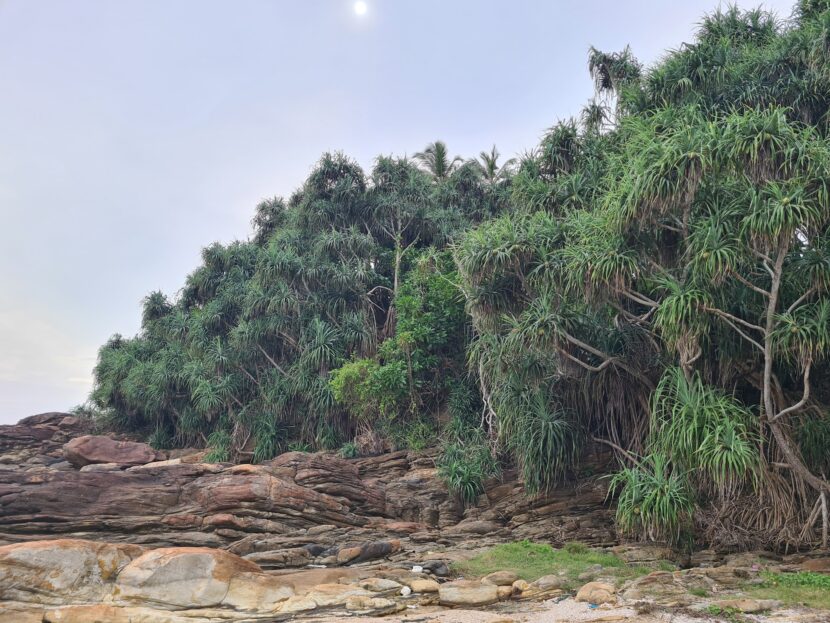 Nilwella, Sri Lanka 2025
Nilwella, Sri Lanka 2025
Painting requires an embodied presence. My eyes, hands and arms are reaching towards that which is disappearing. The image is just out of sight but I sense it. The mangroves are disappearing. What emerges from loss?
Growing on tropical and sub-tropical shores, mangroves belong to the peripheries. As the year has progressed, as I slowly make my way through Butler’s trilogy, as I continue painting mangroves, the sensory organs of the Oankali have begun to merge with the mangrove rhizome root network.
A friend tells me that Édouard Glissant writes about the possibilities of belonging when we have many roots. Glissant asks us to think about identity beyond what we are identified as by colonial (late stage) capitalism, to consider the multiplicity of existence past, present and future. That a poetics of relation is nothing other than the search for a freedom within particular surroundings. 2
I think about ghosts as I continue painting, I focus on the repetition of small dots. The dots are the eyes of ghosts, they are watching me. I am watching them.
Just as the jungle eats corpses and grows flowers that smell like flesh, everything is loved into oblivion and return. 3
Mangroves, among many things, make me question what it means to be rooted, and what it might mean to be rooted and part of a network. I wonder if mangrove root systems could teach us how we might build and sustain life inside these multiple apocalypses?
An estimated 170,000 Tamil civilians were killed by government forces in the last stages of the Sri Lankan civil war 16 years ago. Genocide. No answers. No acknowledgement. But our souls are networks of interlacing, lateral roots. Genocide hidden. But you can feel it, right?
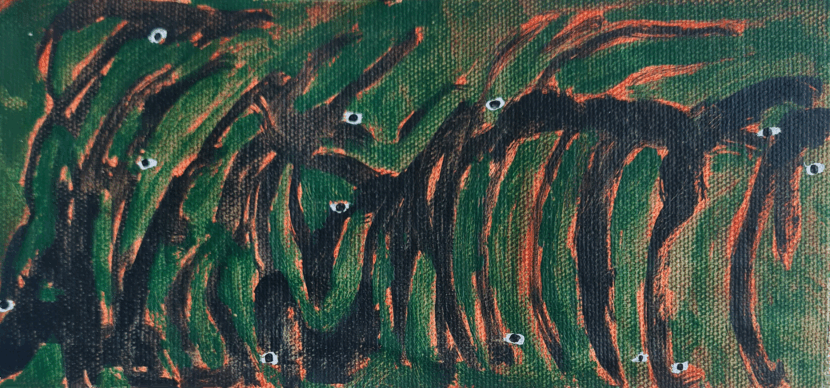 Mangrove Eyes 2 2025
Mangrove Eyes 2 2025
You are hierarchical. We saw it in your closest animal relatives and in your most distant ones. It’s a terrestrial characteristic. – Paul Titus. 1
Butler’s Oankali race rescues humanity, but they will not allow humans to live or breed independently, because of a genetic contradiction described as the combination of our intelligence and hierarchical behavior. This is understood as incompatible and leads to inevitable self-destruction. In Book II we meet Akin, a child born of five parents, three Oankali and two humans. He is the first human-born male construct child. Akin believes that chance can always alter what we think we know. He says you should have one more chance to breed yourselves out of your genetic contradiction. 4
Sensing without seeing. Reaching out. Becoming. Change.
Like a family tree, arborescent systems have a single origin (a root), and everything branches out from that. They maintain fixed relational categories with hierarchical boundaries, these systems are limiting and familiar. However we must not forget that if we are nature and nature is us, we are offered an alternative. 5
The rhizome is a horizontal underground or air network. It allows energy to spread through roots and shoots without a single origin. The rhizome is a mode of non-linear connection, transmission and support. It is a non-hierarchical, decentralised model of becoming.
Painting is a process of excavating images that are living inside of me. This year I am digging in the mud of the mangrove. The Oankali’s sensory arms emerge, sending out transmission signals. The mangroves are disappearing. I paint them. They are hardly there.
Rejecting centralisation and embodying anti-hierarchical, decentralised models, mangroves are adaptable to the shifting tides, the salt and the mud. The knee roots are free from the constraints of usual root systems, they sway in the wind, growing upwards towards the sky. Some of these roots are curling, twisting, dancing around each other, defying gravity. Pores opening, limbs reaching. So many compatible genetic contradictions.
Growing on the edges, making boundaries porous and layered. Mangroves filter the saline out of the seawater: protecting the land from hardening, enabling new growth, plants and insects flourish. You can hide inside a mangrove forest. Now mangroves across the world are being decimated, their fertile borders are being weakened. Now nationstate borders harden, becoming more violent, more racist, more fascist.
Can a mangrove knee root teach us how to be absolutely free? I dream of an end to this way of living, this way is not functioning for the majority of people on earth, nor for the earth itself.
Can edges be soft? Can a border be loving?
In Brixton, there is a group of teenage girls in masks, graffitiing on a wall under a railway bridge on Ferndale Road. Their text reads ‘The only way to live in an unfree society is to be so absolutely free that your existence is an act of revolution.’ 6 My body in relation to their bodies in relation to the bridge that protects them from state surveillance. Transmission and support.
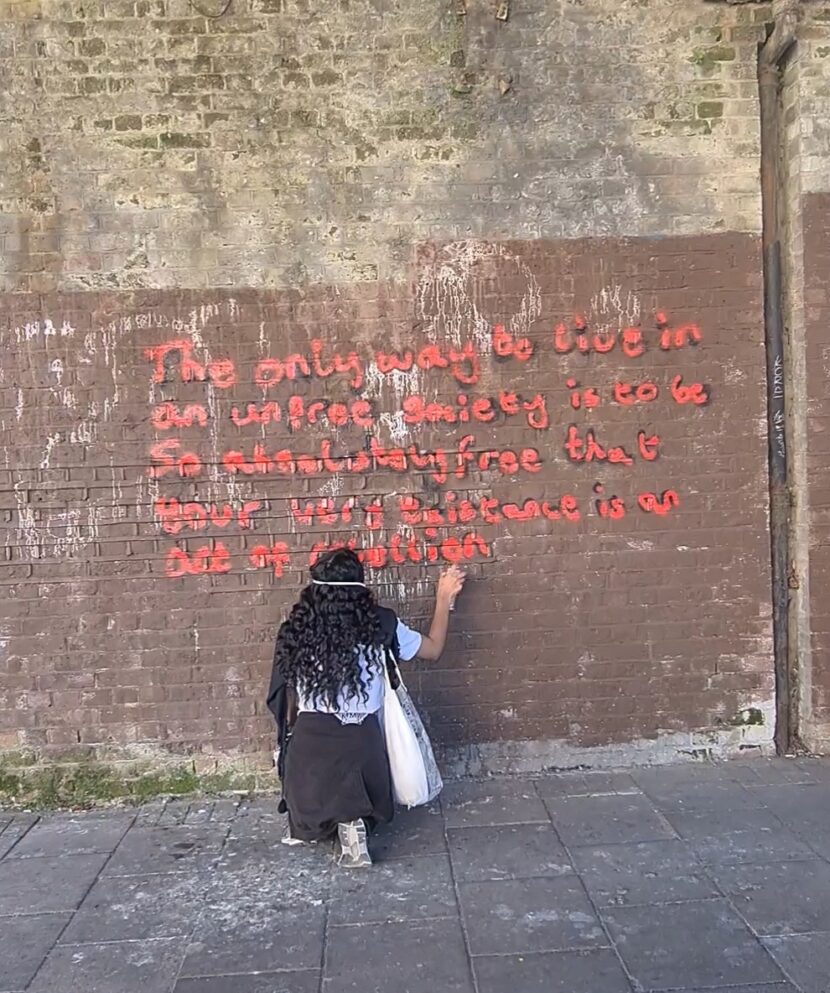 Ferndale Road, London 2025
Ferndale Road, London 2025
I walk past Elvira Graham’s clothing shop on Clapham High Road after hours and see her dancing. The shop has been there for 11 years. Surrounded by her beautiful clothes, lovingly made right there, along with her large collection of fedoras. She dances towards the street, smiling as she moves her body to the music vibrating through the closed door. Elvira’s armroots holding us together. I walk past her shop and see ‘closing down’ written on paper stuck to the window. She tells me the landlord is selling. She says she’s not sure what she will do next. She gives me a book that I didn’t know I needed. We hold each other for a moment, our sadness communes in the sensory contact. Reaching. Looking out [for each other]. How do we perform adaptive models of becoming when the landlord decides to sell? We are also from the jungle, but ours is made of concrete and it’s hard to create our own stable transmission networks here. Is the ground too hard? We need a circular-support system to keep us together and alive.
‘Mangrove’ in Portuguese is mangue. Manguebit is a counter-cultural movement originating in the 1990s from Recife, capital of Pernambuco on the northeastern coast of Brasil. ‘Bit’ is a reference to the computer bit, a unit of information in digital communication. A transmission of knowledge from the mud to the world. Manguebit is a fusion of traditional Brazilian beats like maracatu, ciranda and coco, mixed with hip-hop, punk, funk and dance music. One of the movement’s pioneers and celebrated star, Chico Science, sings
Recife, cidade do mangue
Onde a lama é a insurreição. 7
Recife, city of mangroves
Where the mud is the insurrection
The shores of Recife hold histories that broke humanity. Glissant asks, what comes back from the abyss? The experience of the abyss lies inside and outside the abyss. The Democratic Republic of the Congo (DRC) is the world’s largest cobalt producer, supplying over 60% of the world market. The estimated number of enslaved people in DRC, not including children, is 407,000. 1560 horrors repeat, vibrating throughout history into 2025. They don’t need to show us their pain for us to understand it. Now the horrors are livestreamed, we see them on our cobalt-infused little black mirrors. But why should we need to see it to believe it?
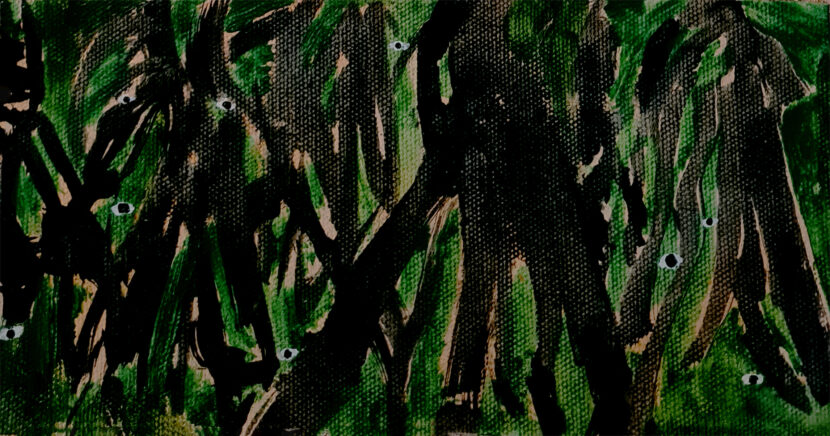 Mangrove Eyes 3 2025
Mangrove Eyes 3 2025
Lilith says to her son Akin that humans persecute their different ones, yet they need them to give themselves definition and status. 4
A symbol associated with Manguebit is an antenna stuck in the mud – receiving signals from all over the world. The periphery is where all knowledge worth knowing and learning has always been. If I close my eyes, I might be able to sense the antenna’s signals.
In an interview with Manguebit band Nação Zumbi, guitarist Lúcio Maia reflects that Recife was a city that grew up on the mud of the mangue, like the crabs that survive in that ecosystem. 8
Baixar o pitch da sua voz
E aumentar o pitch dos seus pensamentos. 7
Lower the pitch of your voice
And increase the pitch of your thoughts
I met a woman in the sauna at Brixton Rec. I will call her Saint. She tells us she is a Jew from Cameroon. She is part of the Baleng tribe. She says her people come from the Western High Plateau. She says there are parts of the country that were never colonised and that her Judaism has nothing to do with the white man. The pores on my skin open. My sweaty cells react to her words as I feel her presence filling the sauna. She says I don’t want to talk about love, I want to talk about how we are gonna feed each other. I am in the sauna with my ears listening, no, I am an antenna in the mud.
A few weeks later I’m outside my studio chasing the last moments of cold spring sunlight, in the late afternoon Saint walks past. I don’t know her name yet so I make a noise ahhhiii calling out. She turns and stares at me – I say ‘the sauna!’ – she smiles and says that she noticed how I was listening to her. I invite her into my studio. I show her my paintings and tell her that the eyes hidden between the mangrove roots are people who don’t usually get to hide. I tell her I am also thinking about the right to be seen and all the tensions in between these things. She says she reads paintings. She says in her culture they say painters have God’s eye, because they are creating new visions. Saint tells me she sees in my work that I don’t feel seen for who I feel I truly am, that I don’t feel like I belong in this space. I take a deep breath.
Saint holds an understanding of the past, present and future, a search for freedom within particular surroundings. Sensing beyond seeing. From deep mud to deeping it.
The stories we tell help us know
Who we are
Who we hope to be
Fear to be
Who we were – or think
We were. 9
A friend in Sri Lanka told me that 40 minutes before the 2004 tsunami hit the island, the animals fled inland. The earth’s plates shifted and unlike the other animals, humans were not able to sense it. Have our sensory organs been damaged? If we could heal them, would we be unable to carry on in the face of the livestreamed genocides? Would the zionist movement collapse, imploding in on itself from guilt and shame? Would we be able to live inside the imperial core without setting fire to everything? Would we smash our little black mirrors into pieces? What parts of our senses have been severed in order to stomach this world?
My eyes stretch to the right and then to the left, resetting my nervous system and I pick up a brush. Painting, repetition of dots. Eyes that see. Ghosts watching. Sensing without seeing. I paint more dots.
Maybe, as the Oankali believe, we are irredeemable. Or maybe there is another way. There are no new ideas. There are only new ways of making them felt. 10 May we look towards our original teachers, the sea, the mangroves, the mushrooms, the fish and the edgelands. Signals vibrating through the mud outwards into the atmosphere. To learn, we must first listen. Sharpen our senses. Hold each other. Reach together. From deep mud to deeping it.
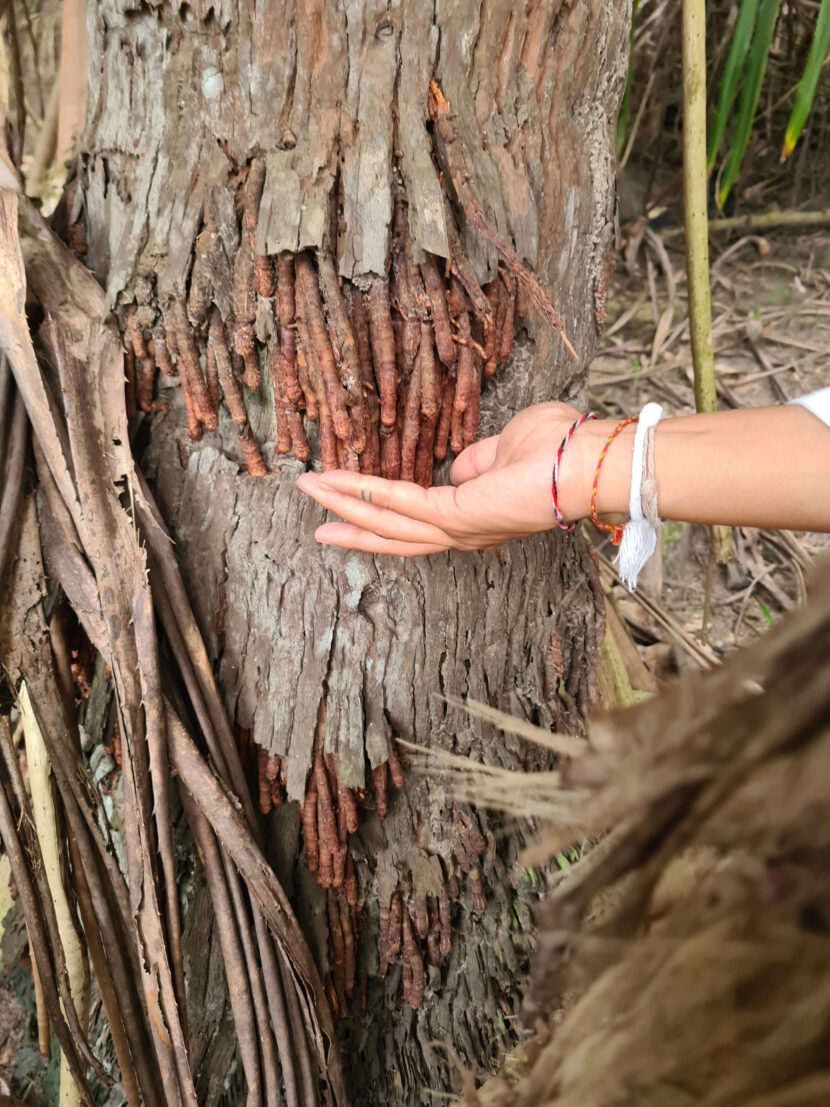 Nilwella, Sri Lanka 2025
Nilwella, Sri Lanka 2025
Meera Shakti Osborne is an artist and youth worker from London. Working across multiple disciplines with a focus on collective healing through creative self-expression. Meera is interested in the use of art as a tool to come together, creating small worlds of protection and openness. They work in zines, oil paint, audio, digital media, textile, breathing, talking, dancing, glitching and love.
Meera is currently based at Metroland Cultures in Kilburn. Recent exhibitions include Hold Me Close (The Forest Is Full of Police) Peer Gallery (2024), A Story of a Life, Women’s Museum, Barking (2024), department of Unruly histories, Cubitt Gallery (2023). Recent residencies include The LOEWE FOUNDATION / Studio Voltaire Award (2023-2025), Research Associate at iniva (2023-2024) Meera has worked with numerous arts and cultural organisations across the UK designing youth programmes and delivering community focused projects. Meera graduated in Design at Central School of Speech and Drama in 2015 and Cairo Institute of Liberal Arts and Science in 2018.
Share:
